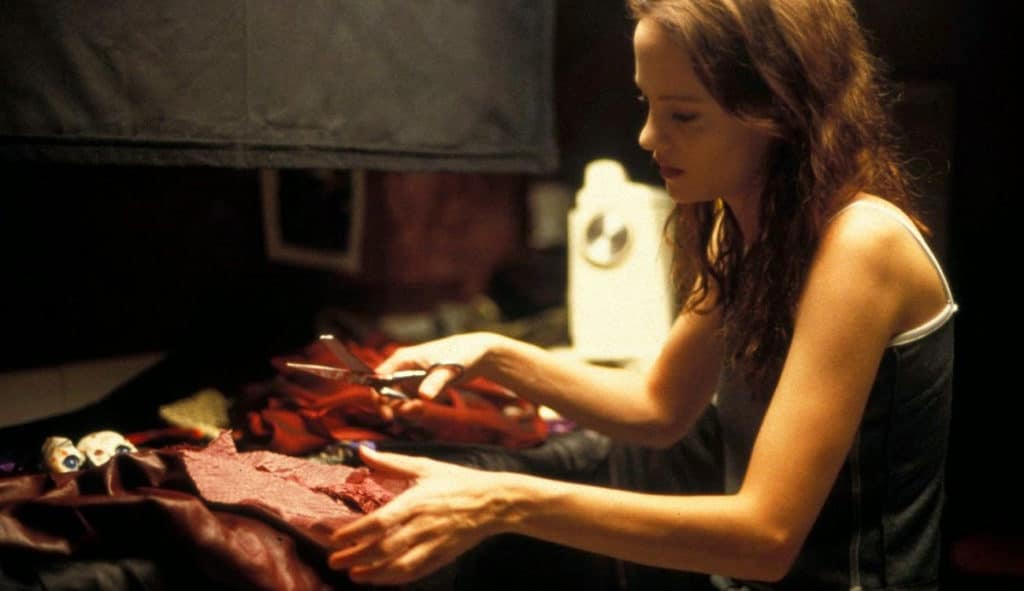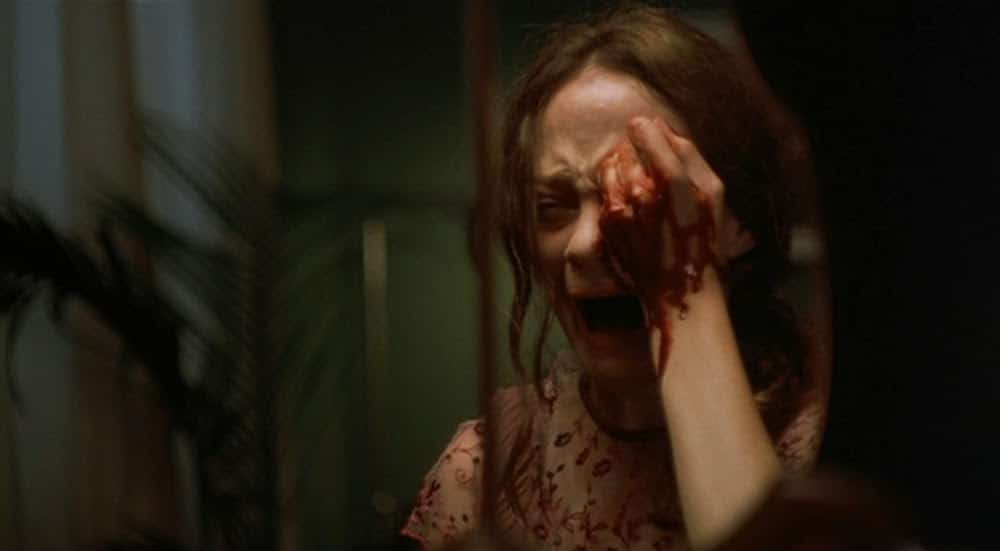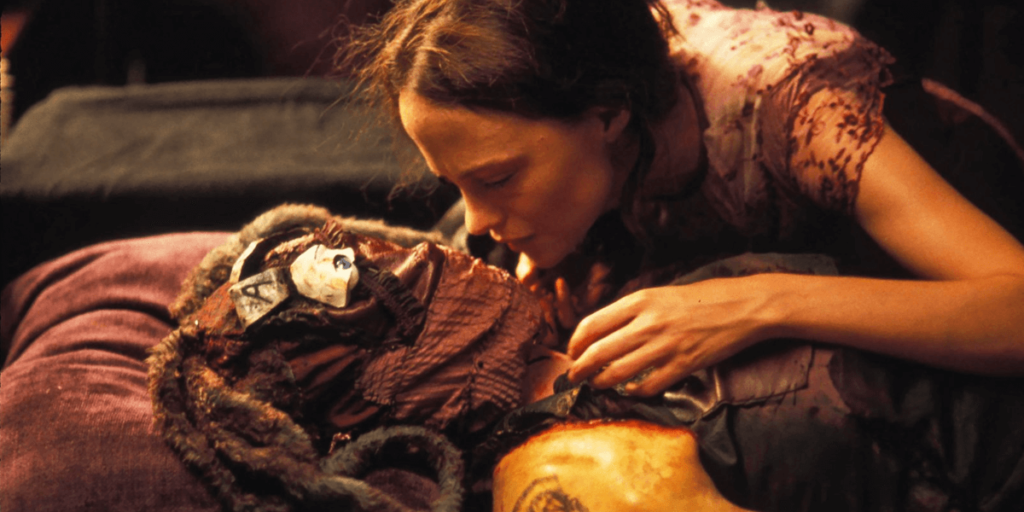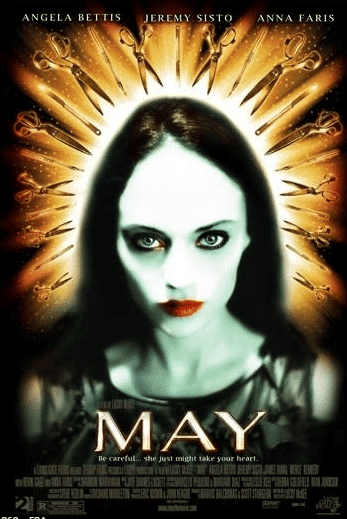
Lucky McKee’s directorial debut May (2002) was not a huge box office success. It initially made far less money than it cost to make, and it baffled many of the audiences who initially got to see it, including the New York Times reviewer Stephen Holden, although he took for his point of reference the slasher genre: he felt that May was a little better than your average slasher. This is less damning with faint praise and more a case of fundamentally misunderstanding what the film intended to do, but thankfully, the film’s reputation amongst more receptive potential fans steadily grew, with its release on home video (I rented this from Blockbuster!) allowing a far broader and more appreciative audience access to this strange, touching and surprisingly intimate horror story of loneliness. The internet as a source of community, though still in its relative infancy in the early Noughties, also helped to promote the film: far from misrepresenting it as an almost-slasher, those more ready to attune to its message saw it as anything but that.
This is preaching to the choir I’m sure, but, look: slashers tend to focus on the victims of an omnipotent, faceless, vengeance- or grudge-driven killer. May is certainly not faceless, and she’s not omnipotent either; she doesn’t bear grudges, she craves care; in fact, it’s her fallibility which continually hurts her. She’s not our antagonist but our flawed protagonist, whose vulnerability prompts her to do horrific things which we are ready to forgive and – by nature of how the film is put together – we share her perspective throughout the film, as closed off from regular human contact and affection as she is. It’s a hard film to watch and it’s hard not be affected by what happens to May, whatever her horrific faults may be. The film is a challenging test of empathy – of how you weigh empathy and why you feel it, despite everything else which happens.
A central element in the film’s success is the casting of Angela Bettis as May herself. Bettis, by now a well-known, frequent collaborator with McKee, was early in her career when she got this leading role, and few genre film fans would have known her – but May made her instantly recognisable, and in turn she makes May a coherent, if jagged and troubled character on screen. It’s impossible to imagine anyone else in this role now. A petite actor, she seems close to being frail in this film, and seems authentically nervy – but there’s something palpably frantic beneath the surface, making its way out from underneath her pathological, crippling shyness. In short, the incoming crisis is signposted early by Bettis’s demeanour, even without the clearer moments of foreshadowing which follow. I always felt that the cover artwork for this film was an odd choice in some ways, with Bettis very starkly lit, looking almost greenish, crowned with sharp-edge items (like dressmaking scissors) and looking coldly at the camera; the film itself is much gentler and more character-driven exercise than the poster suggests, with nothing starkly lit in this way. Even the bloodshed looks suitably autumnal somehow, in keeping with the film’s Halloween time period and October colour palette.

Interestingly though, the film opts to open with one of the last moments in the story – May, screaming as her eye socket pours with blood. So there are no surprises here, at least in one key respect – we know trauma occurs, and therefore there’s a sense of inescapability, that we as the audience are going to find our way back to this grisly, upsetting point by some means – and, after all, there’s no good journey that ends with an eye out. Ocular trauma is a continual theme, as is the relationship between seeing/not being seen. We’re soon whirled through a quick-fire array of moments from May’s childhood, showing that she had a lazy eye as a child and had to wear a corrective patch – which ostracised an already shy girl from her peers, who thought she was odd and disappointingly unpiractical. Her mother’s insistence that wearing the patch will eventually make her ‘perfect’ is another big warning sign: an overbearing parent, an emphasis on physical perfection, and, oh – mom’s gift of a doll, Susie, who would act as May’s de facto best friend, even if May wasn’t allowed to actually get the doll out of its child-unfriendly glass case (more anon) and play with it. Mom’s infamous edict – “if you can’t find a friend, make one” – is tragically short of the mark, but these are words which the grown-up May still chooses to live by. Any port in a storm, maybe.
Tellingly, the interim between childhood and adulthood is not explored at all: we can only infer that May’s parents are dead or otherwise absent, as they are never again mentioned in the story. It’s an absence which clearly weighs heavily. After filling her daughter’s head with life lessons, May’s mother is gone: only the doll survives from that time period, acting as a locus for all of the anxieties and cravings for company which May feels. Through May’s tendency to confide in the doll, and also to ask for advice from the doll, Susie is a quasi-character in its (her?) own right. The slowly cracking glass case links the film’s kooky moments of realism to its more symbolism-heavy, horror content; ironically, the closer May gets to actually holding her “best friend” Susie for the first time, the more her life finally spirals out of control, albeit this is driven by her sudden recent efforts to get into the trappings of adult life, particularly by securing a boyfriend. This is all precipitated by May finally getting her lazy eye fixed; she gets to embody the ‘perfection’ she was raised to look for, as if this was a fairy tale and she needs to look the part in order to play the part. This is also her way, as she understands it, to participate in the world as an equal.
“So many pretty parts…”
To get there, or to make the attempt at least, May has to suspend her tendency to see people not as coherent wholes, but as assemblages of body parts – which she has grown used to evaluating on attractiveness, forgetting the person almost entirely. Again, this comes from her overfamiliarity with doll parts, which can be easily detached from the main body and swapped around; moments of particular crisis see her retreating to her collection of dolls, sitting amongst their scattered limbs and clothes. Doll parts rain down through the opening credits; her final retreat from normality sees her return to dollmaking, her brief attempt to engage with whole people now over as she selects limbs and a body for a ‘friend’. Like Victor Frankenstein, she selects parts based on their beauty (the film knowingly references Frankenstein with street kid Blank’s tattoo) but unlike him, May doesn’t want to make a creature to have them worship her as its creator and she certainly doesn’t recoil in horror at what she’s made; she just wants some compassion.
Up until that point – and because we are always kept on a level with May herself – the camera shows us her unique perspective by focusing closely on parts. Mirroring this, May’s style of dressmaking is to hack things down into parts and then stitch them together again. But as far as bodies go, we see the world via an array of hands, necks, legs: when May whispers to Susie that she likes Adam because she likes him in his entirety, we could find it hard to believe that, because she still fixates on his ‘beautiful’ hands – and so do we, because we can’t do any differently. In a similar way, the frame is often filled with May’s hands: this looks almost choreographed in places, but it’s relevant to how the story plays out because her skills as a seamstress and her craving for touch are so vital to the story here. They are also key to her job: she’s a veterinary nurse by day, which explains how she knows her way around a variety of sutures (with a few dreadful anecdotes about errors) and also how she can sit and cut her hand with a scalpel as a way of “relaxing”.
In her continual nervous hand gestures, we also see May as a woman in a kind of arrested development, lacking the smarts to get through adult situations. Lots of this is almost physically painful to watch – though it goes beyond fidgeting and staring at her hands. It’s writ louder than that. In one of the first scenes shared by May and prospective date Adam (Jeremy Sisto) May’s hair is gathered into pigtails and she’s sucking her thumb. Their initial vibe is more like an older kid guiding a younger; for instance, Adam offers her a cigarette, and has to tell her how to smoke it; her embarrassed responses to these interactions have her embodying a typically shy response, bowing her head and fighting between wanting to be there, and anywhere else.
Whilst Adam is confused by May’s non-sequiturs and lack of social graces, it’s still obvious that he has the upper hand here, able to navigate the situation and to an extent, control it. The same goes for May’s co-worker Polly (Anna Faris) who, like Adam, is often baffled by May’s weirdness, but still feels able to call the shots, even turning it around so it’s her that tries to seduce May, rather than May desperately misreading the cues and attempting to seduce Adam. Both of these supporting characters remain very ambiguous and it’s never fully clear if they genuinely have good intentions towards May, or simply slot into a dominant role with so clearly awkward and confused a person; again, as an audience member kept on May’s own wavelength, we perhaps share May’s uncertainty. And, even when she seems certain – for instance, after fully accepting Dario Argento fan Adam’s assertion that he ‘likes weird’ and emulating a moment in his (Italian language credits!) student horror film – we’re shown in no uncertain terms that she’s wrong.
“I need a real friend – someone to hold.”
The way in which she escalates social errors and misconceptions is painful to watch; although she goes further than most people, you can’t help but feel for her when she makes these soul-shattering mistakes. Seeing May break down in tears when she overhears Adam’s roommates describing her as a freak is a truly horrible thing. And, even when she turns to violence to complete her withdrawal from a world which, even though it only extends over a few blocks, has chewed her up and spat her out in a few short days, we can hate the actions, but never the person who takes them. Even when May’s childish refusal to take Susie out of the box for the children she volunteers with results in a final, bloody piece of foreshadowing as the glass finally shatters and injures them all. Instead of helping the children, May chooses the doll.

It’s a clear indicator that May is done with people, and the final scenes of the film make very clear that May has passed from unfeeling reality into a more fulfilling fantasy. May’s new doll ‘Amy’ (spelled out of broken pottery fragments of what had spelled ‘May’) finally gives her what she wants, extending an arm to hold her and to gently touch her bloodstained face. It’s a moment of pathos which takes us away from the grotesque body horror elements which precede it. Where fantasy and reality begin and end here is unclear; it also feels like the wrong emphasis. After everything, perhaps May deserves her moment of gratification.
This blend of ambiguity and sympathy for a woman retreating from an unfeeling world would crop up again in Dans Ma Peau that same year, and ten years later in divisive indie movies like American Mary (2012) and the underrated Excision (also 2012). There are, of course, other films with some thematic or stylistic overlap, but in the above examples alone we see a fight for feminine agency which reads similarly to May, with some nods to the role of surgery and the search for ‘perfection’ too. Perhaps May crept in there as an influence on the later films. Perhaps it also reminds us that the ugly and the painful aspects of suffering and desire can be subtly handled, a lesson set aside by the time McKee came to direct that exercise in sadism, The Woman (2011). The suffering on display in May is far more adroit, and it certainly doesn’t feel two decades old.
